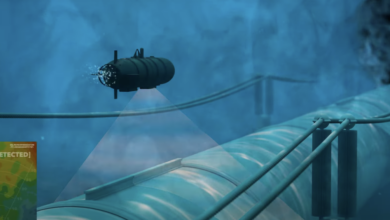Huntington Ingalls Industries (HII) has undocked the US Navy’s USS Zumwalt (DDG 1000) destroyer, featuring a new hypersonic missile launcher.
The outfitting is part of a $155-million upgrade on the warship, which has been carried out at the Pascagoula shipyard, Mississippi, since August last year.
It brings the guided-missile destroyer a step closer to resuming service, but an exact completion date has not been disclosed.
“In partnership with the Navy we are steadfast in our commitment to complete this complex work that adds significant hypersonic capability to Zumwalt,” HII President and CEO Chris Kastner said in a press release.
“We are proud to support the incorporation of the conventional prompt strike for the Navy.”
The upgrade is expected to be complete by 2025, paving the way for testing.
The entire fleet of three Zumwalt warships is expected to have the capability by 2028.
Hypersonic Upgrade
As part of the upgrade, the original twin 155mm Advanced Gun Systems on the destroyer have been replaced with missile tubes for the Conventional Prompt Strike (CPS) weapon, HII said.
Each 87-inch (221-centimeter) tube can hold a trio of Common Hypersonic Glide Body (CHGB) weapons, with a reported range in excess of 2,775 kilometers (1,724 miles).
The CPS has an identical design to the US Army’s ground-based Dark Eagle Long Range Hypersonic Weapon system and the same rocket-boosted missile, only differing in the launch platform.
The unpowered missile, the CHGB, puts the payload to the desired altitude and speed.
After that, the glide vehicle detaches from the booster and dives toward the target through the atmosphere at a hypersonic speed (above Mach 5).
A combination of vehicle speed (considered far exceeding the hypersonic threshold) and unpredictable trajectory make interception extremely difficult, even for a dense, layered missile defense system.
Zumwalt-Class
Originally built for littoral combat, the Zumwalt-class warship features an artillery system capable of firing 155mm guided shells at a distance of 60 nautical miles (69 miles/111 kilometers).
The shell’s projected cost of $800,000 each risked inflating the warship’s overall cost, forcing the eventual fleet reduction from 32 to three warships.
The $9-billion vessel’s electric propulsion system produces 78 megawatts of electricity, enough reserve power for futuristic systems such as next-generation radar systems and directed energy weapons.
It includes a stealthy wave-piercing tumblehome hull design and additional features to reduce spectrum signature, including electromagnetic emissions, radar, acoustic, and infrared.
The 14,500-ton vessel can be outfitted with a host of missiles, including the SM-2 Block IIIAZ and Evolved Sea Sparrow surface-to-air missiles, as well as Tomahawk land-attack cruise missiles.












